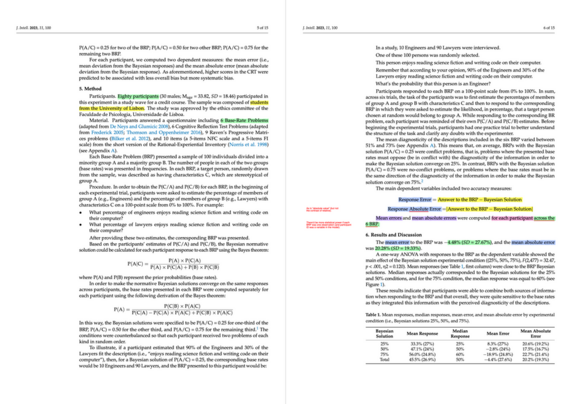Nick Byrd · @ByrdNick
827 followers · 401 posts · Server nerdculture.de"When Cognitive Reflection Leads to Less Overall but More Systematic Judgment Bias":
🤨 Participants who performed better on trick math and logic questions (a.k.a., reflection tests) were MORE (not less) likely to commit a statistical error: a "tendency to underestimate base rates".
🤔 However, the performing well on the trick questions also predicted a LOWER absolute (value of) error.
https://doi.org/10.3390/jintelligence11060100
#decisionScience #cogSci #psychology #probability #CriticalThinking #BaseRateFallacy
#decisionscience #cogsci #psychology #probability #criticalthinking #baseratefallacy
Alice · @alice
19 followers · 167 posts · Server lgbtqia.spaceExplain the base rate fallacy like I'm 5.
_
The base rate fallacy is when you make a wrong guess because you forget to think about how common something is.
Imagine you and your friends are playing a game where you have to guess what animal is hiding in a box. Your friend tells you that there are 100 animals in the box and 90 of them are rabbits and 10 of them are lions.
If you see the animal and think it's a lion because it looks like one you saw before, you might guess that it's a lion. But just because it looks like a lion, it doesn't mean that it is a lion. You need to think about how many lions and rabbits there are in the box to make a better guess.
This is what the base rate fallacy is all about. When we're trying to guess or predict something, we need to think about the base rate or how common something is. If we don't think about the base rate, we might make a wrong guess.
So, always remember to think about how common something is when you're trying to guess or predict something. That way, you can make a better guess!
_
If I think I see a lion, how likely is it to actually be one?
_
The likelihood that what you see is actually a lion depends on two things: your prior belief about the base rate (the proportion of lions and rabbits in the box), and the information you have about the appearance of the animal.
If the base rate is 90% rabbits and 10% lions, and you think you see a lion, you need to take into account that the prior probability of seeing a lion is lower compared to the probability of seeing a rabbit. So, even though you think you see a lion, it is still more likely that it is a rabbit.
In this scenario, you would need additional information to determine the exact likelihood that what you see is actually a lion. This information could come from other sensory cues, such as hearing a roar, or from previous experiences or knowledge about the behavior of lions and rabbits.
To calculate the exact likelihood, you would need to use Bayes' theorem, which is a mathematical formula that combines prior probabilities with new information to update our beliefs. But to understand Bayes' theorem, you need to have a good understanding of probability and statistics, which is beyond the scope of a simple explanation for a 5-year-old.
_
#ChatGPT #teaches #statistics #BaseRateFallacy
Feel free to argue with our #RobotOverlords in the replies.
#chatgpt #teaches #statistics #baseratefallacy #robotoverlords
Remko Tronçon · @remko
35 followers · 58 posts · Server mas.to@jbaert Ik hoop dat ze dat niet doen: 26% True Positive, 9% False Positive ... Als 10% van de klas ChatGPT gebruikt, dan gaat 75% van de ‘dit is een AI’ voorspellingen een valse beschuldiging zijn. #BaseRateFallacy
Jonathan D. Abolins · @JonAbolins
278 followers · 851 posts · Server mastodonapp.ukA good thread explaining Base Rate Fallacy & #Covid #Perceptions #Statistics #Logic #Analysis #BaseRateFallacy #Fallacies https://threadreaderapp.com/thread/1615018133814657033.html
#covid #perceptions #statistics #logic #analysis #baseratefallacy #fallacies
Jordan Kay · @_Jordan
358 followers · 2551 posts · Server mastodon.socialIf you (correctly) knew to debunk the message behind “most people dying of COVID were vaccinated” but not that behind “most people with Long COVID had a mild initial case,” maybe ask yourself why. #BaseRateFallacy
Nick Byrd · @ByrdNick
368 followers · 68 posts · Server nerdculture.deAnother #framingEffect?
In "The Allure of #Simplicity", Jack Justus, Samantha Wakil and I run three #experiments on people's evaluations of explanations.
Merely labeling explanations 'simpler' or 'simplest' made people more vulnerable to the #baseRateFallacy and the #conjunctionFallacy!
Jack and I present our data and conclusions at #PSA2022 on Saturday.
#xPhi #PhilSci #CogSci #DecisionScience #Rationality #Epistemology #Psychology #Science #SciComm #Virtue
#framingeffect #simplicity #experiments #baseratefallacy #conjunctionfallacy #PSA2022 #xPhi #philsci #cogsci #decisionscience #rationality #epistemology #psychology #science #scicomm #virtue
krishmvasan · @krishmvasan
3 followers · 16 posts · Server qoto.orgA wonderful lecture on #bias #rationality #bayes #baseratefallacy and other topics :
#rationality #bias #baseratefallacy #bayes



